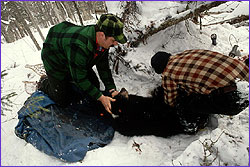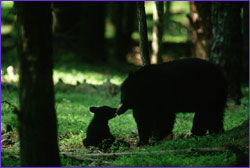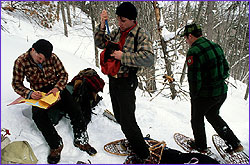 |
 |
Secrets of Hibernation
Part 2 | back to Part 1
Bear essentials
Over-wintering black bears do other extraordinary things—things that might someday benefit humans. For starters, snoozing bears are able to gain all the sustenance they need entirely from within their own bodies. Fat tissues break down and supply water and up to 4,000 calories a day; muscle and organ tissues break down and supply protein.
|  Biologists are eagerly teasing physiological secrets out of hibernating black bears—secrets that may hold benefits for humans.
Biologists are eagerly teasing physiological secrets out of hibernating black bears—secrets that may hold benefits for humans.
|
Our bodies do the same thing when we're starving—with one crucial difference: Our bodies can't restore muscle and organ tissue, which those of hibernating bears can. Bears' bodies are somehow able to take urea—a chief component of urine that is produced during tissue breakdown and that, if left to build up, becomes toxic—and use the nitrogen in it to build new protein.
Even though a hibernating bear drinks no water, it does not become dehydrated. In a 1973 study published in the American Journal of Physiology, hibernation expert Ralph Nelson and colleagues at the Mayo Clinic and Mayo Foundation found that the three hibernating bears they studied were in "almost perfect water balance" after about 100 days of hibernation, during which they swallowed not a single drop of water. Nelson's team and other researchers want to learn how bears accomplish this metabolic feat, during which the amount of urine entering the kidneys drops by 95 percent, in hopes of using the information to help treat people suffering from chronic kidney failure.
Hibernating bears also have what would seem to be dangerously high cholesterol levels. Because they live off their own fat, their cholesterol levels are more than twice what they are in summer (and more than two times higher than those of most people). But bears evince no signs of hardening of the arteries or the formation of cholesterol gallstones. Research has shown that hibernating bears generate a form of bile acid that, when administered to people, dissolves gallstones, eliminating the need for surgery. Despite being cooped up in a space about the size of a doghouse, hibernating black bears also appear to avoid muscle cramping and degenerative bone loss. How they accomplish this remains a mystery.
 Delayed implantation ensures that cubs only come along when sufficient food resources exist.
Delayed implantation ensures that cubs only come along when sufficient food resources exist.
|
|
Another mystery goes by the name "delayed implantation." A female will carry a fertilized egg in her womb for many months. The egg is ready to attach itself to the uterine wall and begin developing into a fetus. But it doesn't do so until the female's body gives some unknown signal. This adaptation allows bears to time the birth of their cubs, so they're not born too early or too late. It also gives the mother a way out if food is scarce: If she has not accumulated enough fat by the time she settles into her den to hibernate, the egg will spontaneously abort. Some biologists see this neat trick as a natural mechanism to control population.
Evidence is mounting that hormone-like substances in hibernating bears may control all these physiological tricks. When injected into other species, both those that hibernate and those that don't, these substances engender hibernation-like effects. Who knows? If people can be made to hibernate, perhaps sufferers of seasonal-affective disorder, or SAD, will find the ultimate relief: a winter-long snooze.
Want to hibernate?
Human hibernation may not be as far-fetched as it sounds. In December 2000, Gerhard Heldmaier, a professor at the University of Marburg in Germany and chairman of the International Hibernation Society, announced the discovery of two genes that are thought to trigger hibernation. These genes direct enzymes to burn fat rather than carbohydrates, thereby equipping the body for hibernation. "There is no real reason," Heldmaier told London's Independent on December 3rd, "to say that humans are so different from other mammals that they are unable to enter hibernation."
|  Can slumbering black bears provide insights into better preserving transplant organs, injured soldiers, even space travelers? Biologists believe so.
Can slumbering black bears provide insights into better preserving transplant organs, injured soldiers, even space travelers? Biologists believe so.
|
Although it's possible that people may one day be able to nod off for the winter, the most likely applications of human hibernation involve medicine and perhaps space travel. Doctors might be able to preserve transplant organs longer if those organs could go into hibernation, as a true hibernator's organs do. The U.S. Army is reportedly eager to look into the potential of using hibernation to preserve wounded soldiers during transport from battlefields to hospitals. And NASA has sponsored research on using hibernation for long-distance space travel.
Spring break
In January, a pregnant black bear wakes up long enough to give birth in the den to one or more cubs. She then slumbers anew, rousing herself every now and then to lick the cubs and otherwise tend to them. The cubs, meanwhile, do not hibernate but suckle their mother, safely warmed by her sparsely furred belly. At some unknown cue, mom and cubs, which are now about three months old and weigh four to eight pounds, leave the den behind and get on with their lives in the world at large.
Weight loss is extreme among those leaving the nest. Between early fall and late spring, male black bears will typically drop between 15 and 30 percent of their body weight, while lactating mothers can lose up to 40 percent. Despite this grave weight loss, over 99 percent of black bears survive the winter. Most that do succumb do so because of den flooding or predators and not from starvation. A slumbering bear has all it needs within.
Peter Tyson is editor in chief of NOVA Online.
Further Reading
"A Bear in Its Lair," by Lynn Rogers. 1981. Natural History, Vol. 90, No. 10.
"Metabolism of Bears Before, During, and After Winter Sleep," by Ralph A. Nelson, Heinz W. Wahner, James D. Jones, Ralph D. Ellefson, and Paul E. Zollman. American Journal of Physiology, Vol. 224, No. 2, February 1973.
Life in the Cold: The 11th International Hibernation Symposium, Gerhard Heldmaier and Martin Klingenspor, eds. New York: Springer-Verlag, 2000.
Photos: (1-7) Corbis Images
Animal Transformations |
Miracle of Rice
Secrets of Hibernation |
Build a Rice Paddy |
Resources
Transcript |
Site Map |
Japan's Secret Garden Home
Editor's Picks |
Previous Sites |
Join Us/E-mail |
TV/Web Schedule
About NOVA |
Teachers |
Site Map |
Shop |
Jobs |
Search |
To print
PBS Online |
NOVA Online |
WGBH
© | Updated December 2000
|
|
|